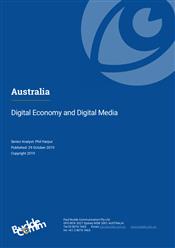Australia - Digital Economy and Digital Media

Last updated: 29 Oct 2019 Update History
Report Status: Archived
Report Pages: 77
Analyst: Sebastien De Rosbo
Synopsis
There are two major categories of paid online video content: Pay-per-view video-on-demand (PVOD) and subscription video-on-demand (SVOD) services. SVOD has emerged as the major category of paid online content in Australia.
Streaming is closing in on broadcast TV. There is a rapid increase in the rate of adoption of SVOD occurring where high-quality broadband is already available. The growth in the uptake of catch up and live traditional TV streaming services had slowed down, with SVOD penetration on track to overtake it. The NBN is accelerating this trend as the mass deployment of high-quality broadband takes place and will significantly decrease the cost of delivery of SVOD.
Netflix has emerged as the SVOD dominant operator, but both Stan and Presto have built up a significant customer base, and both have the substantial financial resources of their backers at their disposal.
FOXTEL during the last few years has struggled to increase pay TV penetration in Australia. Viewing habits have also been affected by the advent of catch-up TV services, which are available from the main broadcasters. In addition, subscription video services from VOD operators such as Stan and Netflix are further eroding live TV viewing as subscribers choose instead to watch programs at a time of their choosing.
Also the distribution advantage held by FOXTEL is slipping away as the NBN becomes built out over a greater number of premises, so expanding the reach of capable broadband infrastructure which enables subscribers to access OTT and IPTV content. These changing market conditions are impacting both the FTA and pay TV industries.
With the move towards 5G well and truly underway it is important to look at what will be the value of IoT infrastructure to the development of a network that will be dominated by sensors and devices.
The infrastructure that is now being built offers a range of features such as ubiquitousness, affordability, low latency, high speed and high capacity. It will link millions of devices, such as sensors, that will enable us to manage our environment, traffic, infrastructures, and our society as a whole much more efficiently and effectively.
The ‘Internet of Things’ (referring more to personal devices such as wearables and smartphones) and M2M (referring to a more industrial use based on sensors) transform every single sector of society and the economy and it will be out of this environment that new businesses – and indeed new industries – will be born. 5G will take a leadership role in the development of M2M but the NBN is also a key infrastructure element as more and applications will require high quality video. These developments are closely linked to big data, data analytics, cloud computing and data centres and these elements all play a fundamental role in the success of this new infrastructure.
Companies covered in this report:
Optus, Telstra, IBM, Vodafone, Sense-T, FetchTV, Bigpond, Google, Apple, ABC, Netflix, NBN Co, Hulu, Stan, AUSTAR, FOXTEL, Optus, TransACT,
Key Developments
- The Australian IoT industry reached nearly $20 billion by 2020.
- Market growth is driven by rising demands for smart devices, increasing demand for analytics, cloud platform adoption and growth of wireless networking technologies.
- Foxtel will continue to lose ground to streaming media providers such as Netflix and Stan.
Hot topics
Internet of Things, IoT, M2M, sensors network, smart grids, smart factories, NBN, smart cities, business opportunities, sector transformation.
Related Reports
- Australia - Telecoms, Mobile and Broadband - Statistics and Analyses
- Australia - Data Centre Market
- South Pacific Islands - Telecoms, Mobile and Broadband - Statistics and Analyses
- Samoa - Telecoms, Mobile and Broadband - Statistics and Analyses
- Papua New Guinea - Telecoms, Mobile and Broadband - Statistics and Analyses
- New Zealand - Telecoms, Mobile and Broadband - Statistics and Analyses
- French Polynesia - Telecoms, Mobile and Broadband - Statistics and Analyses
- New Caledonia - Telecoms, Mobile and Broadband - Statistics and Analyses
- Vanuatu - Telecoms, Mobile and Broadband - Statistics and Analyses
Share this Report
TMT Intelligence
A platform to scale your intelligence tasks
Monitor critical insights with our AI-powered Market Intelligence Platform gathering and analyzing intelligence in real time. With AI trained to spot emerging trends and detect new strategic opportunities, our clients use TMT Intelligence to accelerate their growth.
If you want to know more about it, please see:
Research Methodology
BuddeComm's strategic business reports contain a combination of both primary and secondary research statistics, analyses written by our senior analysts supported by a network of experts, industry contacts and researchers from around the world as well as our own scenario forecasts.
For more details, please see:
More than 4,000 customers from 140 countries utilise BuddeComm Research
Are you interested in BuddeComm's Custom Research Service?
Hot Topics
News & Views
Have the latest telecommunications industry news delivered to your inbox by subscribing to BuddeComm's weekly newsletter.